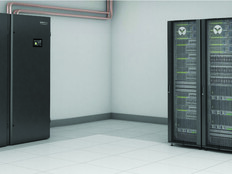Federal Agencies Experience Mixed Data Center Optimization Results
While some federal agencies were on track late last year to meet Office of Management and Budget data center cost reduction and consolidation goals, a number had only made limited progress toward reaching other data center optimization objectives, according to a Government Accountability Office report published in April.
The OMB’s Data Center Optimization Initiative encouraged agencies to increase data center efficiency in several areas, potentially decreasing operating costs and agencies’ environmental footprint. The OMB had previously directed agencies to reduce the number of outdated or duplicative data centers in its 2010 Federal Data Center Consolidation Initiative.
The new DCOI recommended agencies shut down at least 25 percent of their tiered data centers — facilities that include a separate physical space for IT infrastructure, an uninterruptible power supply, a dedicated cooling system or zone and a backup power generator — by the end of fiscal year 2018.
Noting that server rooms and closets pose security risks and management challenges, the OMB also advised agencies to shut down at least 60 percent of any nontiered data centers and to optimize data center value even more by measuring their performance and working to achieve certain targets for server utilization, power usage and other processes.
As of August 2018, 13 federal agencies — slightly more than half of the 24 participating in the DCOI initiative — had met or had plans to meet their data center closure targets, according to Carol Harris, GAO director for IT management issues.
Fewer, though, were scheduled to achieve the OMB’s performance measurement objectives.
“Two-thirds of agencies had also met or planned to meet their cost savings goals,” Harris says. “However, only three agencies met or planned to meet their data center optimization goals.”
Agencies Advance Toward Some Aims, Yet Not Others
According to findings from the GAO’s performance audit, 13 agencies reported they had already met the OMB’s tiered data center closing goal, and another three agencies intended to meet the goal by the end of the fiscal year. Six did not plan to meet the objective; two were exempt because they had one or no data centers.
Eleven agencies with nontiered data centers reported they’d already closed 60 percent of them, per the OMB’s goal, and three more planned to do so by the end of fiscal year 2018. Nine did not plan to meet the goal; one of them, the Social Security Administration, did not report having any nontiered data centers.
According to Harris, many agencies focused on closing data centers as a technique to achieve sufficient cost savings — another DCOI stipulation.
The OMB specified agencies should reduce annual costs that were attributable to physical data centers by at least 25 percent, which would result in savings of at least $2.7 billion for fiscal years 2016-2018.
While five did not plan to meet the goal by the 2018 deadline, 13 agencies said they had reached or planned to reach or exceed their OMB goals. Although some agencies weren’t given cost reduction targets — the Department of Education, for example, didn’t report any tiered data centers in its inventory — three agencies that did not have targets also said they had achieved cost savings.
In all, 22 agencies had achieved $1.94 billion in cost savings from 2016-2018, and 21 agencies identified an additional $0.42 billion in planned savings through the end of fiscal year 2018.
Still, the resulting total — $2.36 billion — comes to roughly $0.37 billion less than the OMB’s original $2.7 billion overall savings goal.
The DCOI also tasked federal agencies with measuring their progress toward specific server utilization, energy metering, power usage, facility utilization and virtualization-based data center optimization goals.
Agencies reported the most success in power usage effectiveness — defined by the DCOI as the proportion of energy used by IT equipment compared to the total energy used by the data center — and virtualization. Eight agencies had reached the target power usage goal; six reported they’d met the virtualization target of four operating systems for every one physical server.
However, only three agencies had met DCOI energy metering goals, and fewer had reached the facility and server utilization targets. Nine agencies had only met one of the five optimization targets, and 10 had not met any.
In addition, five of the 22 applicable agencies weren’t able to assess server utilization or power usage effectiveness because they either hadn’t implemented automated monitoring tools at any data centers — another one of the OMB’s requests — or had experienced shortcomings in adding the tools.
Buy-In and Combining Resources Can Accelerate Optimization
The GAO report also highlighted some of the practices that helped six agencies successfully meet their DCOI goals.
Agencies that increased data center efficiency, according to the GAO, obtained executive leadership support for the effort and utilized cloud and shared services. Some increased virtualization used or employed an organizationwide communications plan to facilitate consolidation and optimization activities’ adoption.
A previous GAO report suggested numerous factors — including having a decentralized organizational structure and competing priorities for resources — had resulted in agencies only making limited progress toward reaching OMB optimization goals through 2016. The majority had not fully addressed those concerns by December 2018, according to the GAO.
Agencies have also provided a number of reasons why they feel they haven’t been able to reach their optimization objectives. The Department of Veterans Affairs, for instance, said its project implementation being dependent on funding approval could potentially push cost savings to 2019 or beyond.
In response to the April 2019 data center report, some agencies said they felt certain DCOI stipulations weren’t applicable, due to proposed changes to the initiative the OMB shared in November 2018. These would focus efforts on agencies’ larger, tiered data centers; alter the metrics used to monitor data center performance; and have the OMB and agencies work together to set individualized closure and savings goals.
The OMB has not clarified, though, when the changes will be finalized, according to Harris, and the GAO has been told the August 2016 DCOI guidance will remain in effect until any revisions are formally issued.
“The timing of OMB’s proposed guidance changes, and the fact they were not finalized before the report was issued, made responding to agency comments a little interesting,” Harris says. “A number referred to OMB’s proposed guidance changes as reasons for their particular responses, or for asking that their recommendations be closed.”
While agencies await clarification on the changes, the GAO, which has issued several reports on data center optimization in recent years, is already at work on its next one.
“GAO is required by the Federal Information Technology Acquisition Reform Act to conduct annual reviews through fiscal year 2020,” Harris says. “We are just beginning work on our next review, which should be completed by spring 2020.”






_0.jpg)



